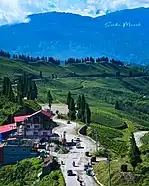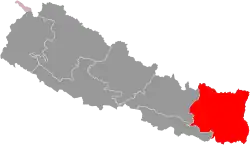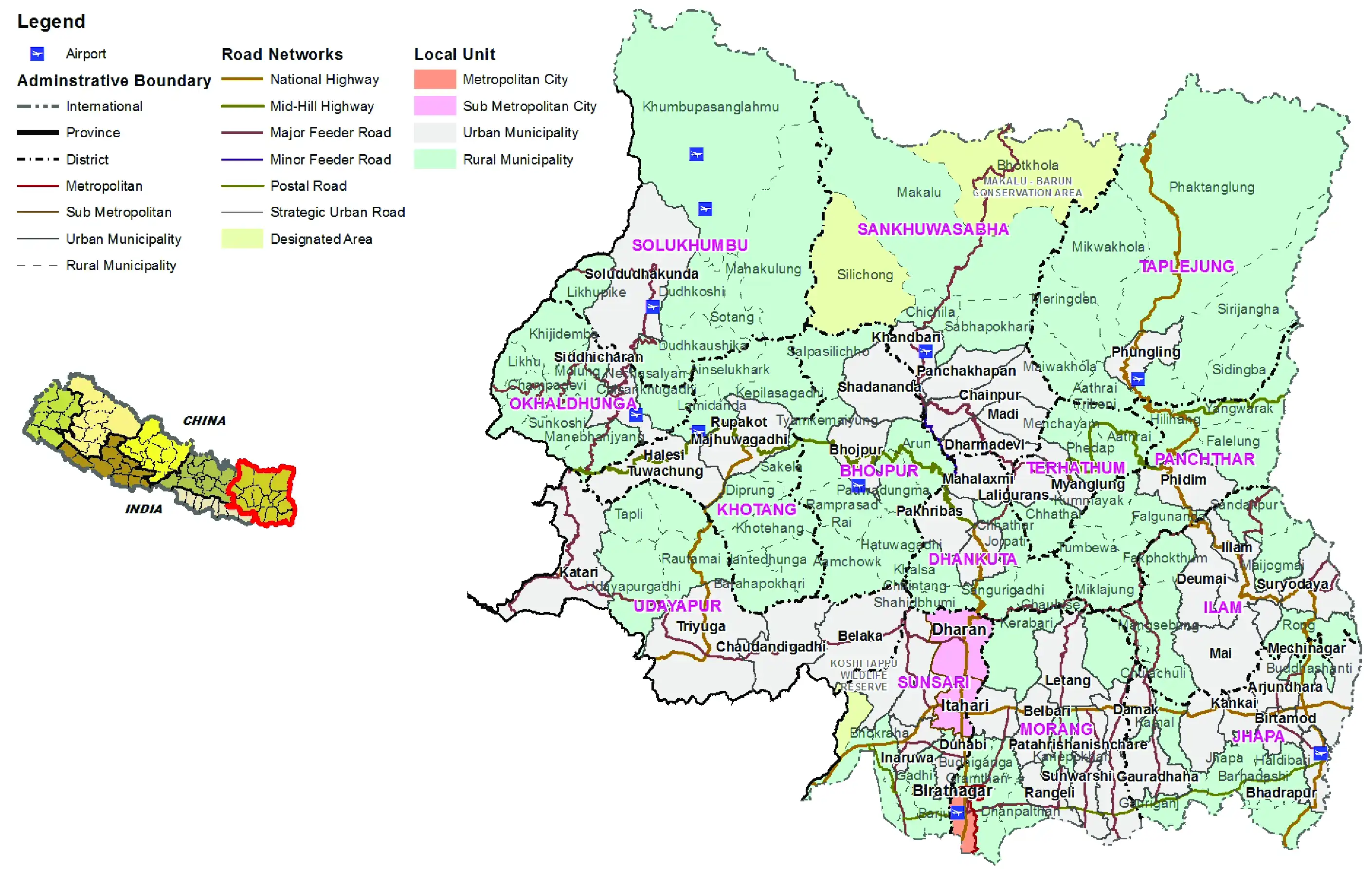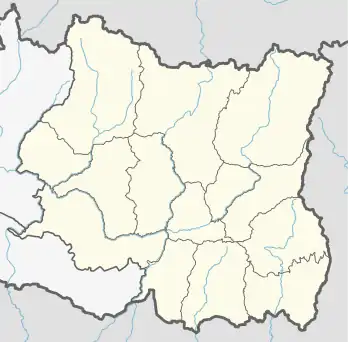Koshi Province (Nepal)
Koshi Province (Nepali: कोशी प्रदेश),is one of the seven federal provinces of Nepal. It was established in 2015 by the current constitution of Nepal. It was originally called Province No. 1. On March 1, 2023, it was renamed after the Kosi River. The capital city is Biratnagar.[5]
Koshi Province
कोशी प्रदेश/ཤར་པ་ཀླུང | |
|---|---|
     | |
 Location of Eastern part of Nepal | |
Koshi Pradesh | |
| Coordinates (Biratnagar): 26°27′15″N 87°16′47″E | |
| Country | |
| Formation | 20 September 2015 |
| Named as Koshi Pradesh | 1 March 2023 |
| Named for | Koshi River |
| Capital | Biratnagar |
| Largest city | Biratnagar |
| Districts | 14 |
| Government | |
| • Type | Self-governing Province |
| • Body | Government of Koshi Province |
| • Governor | Parshuram Khapung |
| • Chief Minister | Kedar Karki Nepali Congress |
| • High Court | Biratnagar High Court |
| • Koshi Provincial Assembly | Unicameral (93 seats) |
| • Parliamentary constituency | 28 |
| Area | |
| • Total | 25,905 km2 (10,002 sq mi) |
| • Rank | 2nd |
| Highest elevation | 8,848 m (29,029 ft) |
| Lowest elevation (Kechana Kawal) | 60 m (200 ft) |
| Population | |
| • Total | 4,961,412 |
| • Rank | 4th |
| • Density | 192/km2 (500/sq mi) |
| • Rank | 4th |
| • Households | 1,191,556 |
| Demonym(s) | Purbeli, Kosheli, Koshyali |
| Demographics | |
| • Religions |
|
| • Ethnic groups | |
| • Sex ratio | 91.48 ♂ /100 ♀ (2011) |
| Development Parameters | |
| • GDP per capita | US$1267 (3rd) |
| • Poverty rate | 0.127[3] |
| • Literacy | 79.7% |
| • Life Expectancy | 69 |
| • HDI | 0.553 |
| Time zone | UTC+5:45 (NST) |
| Geocode | NP-ON |
| ISO 3166 code | NP-P1 |
| Vehicle registration | PROVINCE 1 AB XXXX |
| Official language | Nepali Limbu[4] |
| Other Official language(s) | Bantawa |
| GDP (Nominal) | US$9 Billion (2nd) |
| Website | koshi |
The province is bordered by the Tibet of China to the north, the Indian states of Sikkim and West Bengal to the east, and Bihar to the south, and Bagmati Province and Madhesh Province to the west.[6][7][8] According to the 2021 Nepal census, there are around 5 million people in the province, with a population density of 190 per square kilometre.[9] As per the 2011 Nepal census the province had around 4.5 million people.[10]

References
- "NepalMap profile: Province No. 1". Archived from the original on 25 January 2021. Retrieved 8 April 2023.
- "NID | Overview".
- "Province Wise Multidimensional Poverty Index".
- "सरकारी कामकाजको भाषाका आधारहरूको निर्धारण तथा भाषासम्बन्धी सिफारिसहरू (पञ्चवर्षीय प्रतिवेदन- साराांश) २०७८" (PDF). Language Commission. Language Commission. Archived from the original (PDF) on 6 September 2021. Retrieved 28 October 2021.
- "Nepal's 'Province 1' renamed 'Koshi' after country's largest river". Canada Asia Sustainability Tracker. 2023. Retrieved 9 March 2023.
- "Biratnagar celebrates its status of provincial capital". The Himalayan Times. 2018. Archived from the original on 20 January 2018. Retrieved 19 January 2018.
- "Locals intensify protest in Dhankuta after Biratnagar named as provincial HQ". Kathmandu Post Ekantipur. 2018. Archived from the original on 18 January 2018. Retrieved 19 January 2018.
- "Nepal government announces Provincial Capitals and Chiefs". DDI News. 2018. Archived from the original on 19 January 2018. Retrieved 19 January 2018.
- "राष्ट्रिय जनगणना २०७८ प्रारम्भिक नतिजा". cbs.gov.np (in Nepali). Central Bureau of Statistics, Nepal. 2022. Archived from the original on 26 January 2022. Retrieved 26 January 2022.
- "Province 1: Call for opportunities in the land of great promise". Kantipur Publications Pvt. Ltd. 12 August 2015. Archived from the original on 6 September 2017. Retrieved 5 September 2017.
This article is issued from Wikipedia. The text is licensed under Creative Commons - Attribution - Sharealike. Additional terms may apply for the media files.
